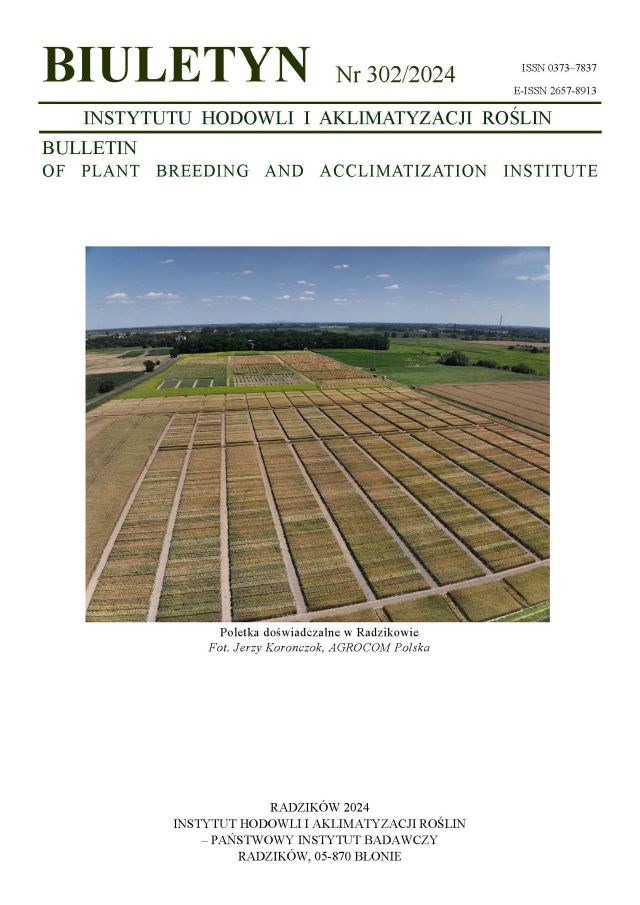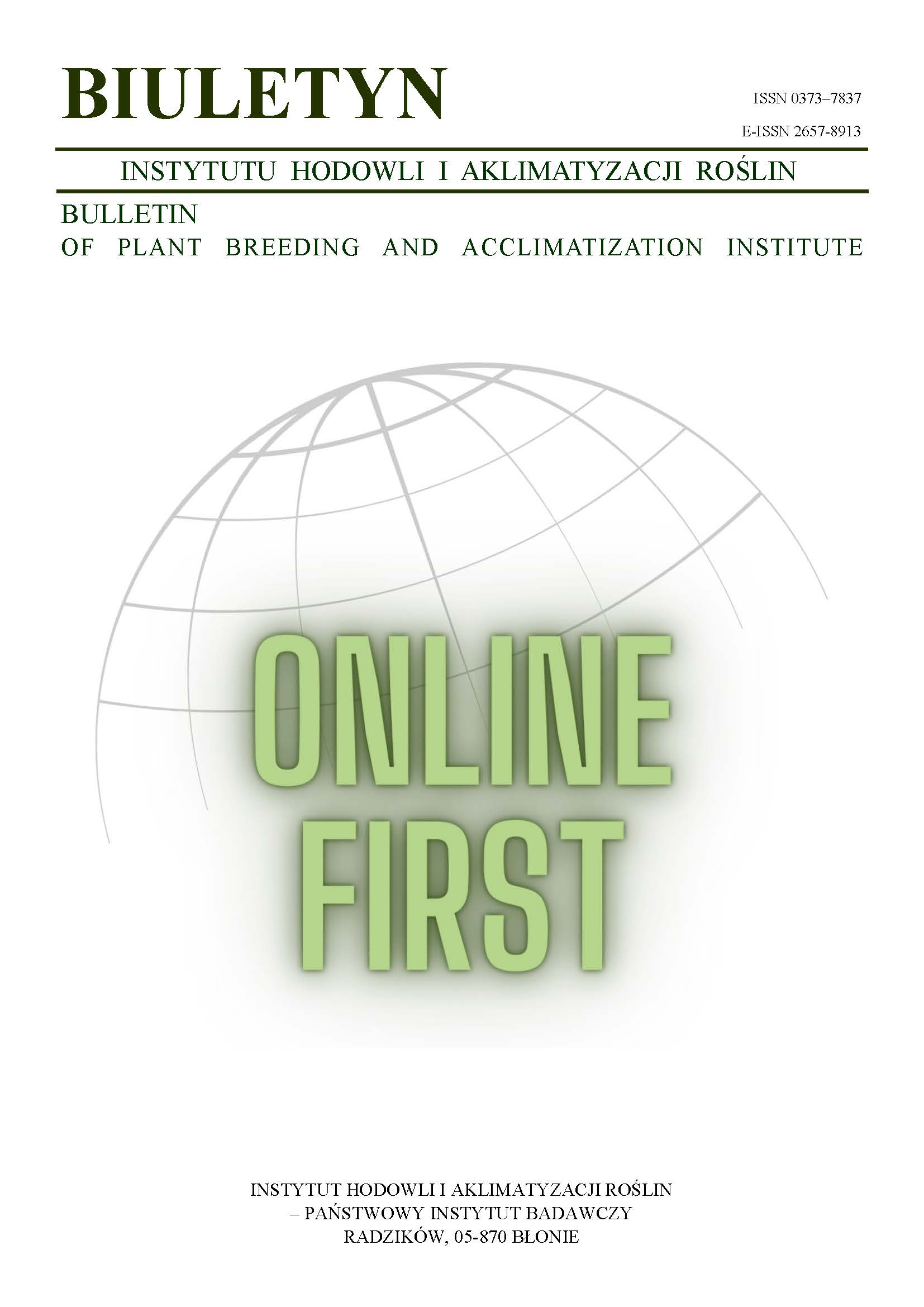Genetic variation of quantitative traits in hull-less mutants of spring barley (Hordeum vulgare L.)
Wojciech Rybiński
office@igr.poznan.plInstytut Genetyki Roślin PAN, Poznań (Poland)
Elżbieta Adamska
Instytut Genetyki Roślin PAN, Poznań (Poland)
Abstract
Hull-less mutants of spring barley obtained by mutation induction from the hull-less breeding line 1N/86 constituted the material for the performed studies. Two chemomutagens — N-nitroso-N-methylurea (MNU) and sodium azide (NaN3) were used for the treatment. Among the mutants 19 forms, representing different morphotypes and yielding ability, were chosen to field experiments performed in the years 2000–2002. The paper presents genetic variation of yielding and yield structure parameters of the mutants and their initial form. The results were statistically elaborated considering the years of the experiments and the analyzed traits. As compared to the initial forms, the mutants were characterized by a broad spectrum of variation for the traits. Generally, in the three years of experiments, the mutants showed lower yielding ability and decrease of the yield structure parameters. In spite of this, several mutants yielded above their initial form and exceeded it in the yield structure traits. They may constitute an interesting initial material for breeding programs of hull-less barley.
Keywords:
barley, genetic variation, hull-less barley, mutants, yield structureReferences
Bhatty R. S., Berdhal J. D., Christison G. J. 1975. Chemical composition and digestible energy of barley. Can. J. Anim Sci., 55: 759.
DOI: https://doi.org/10.4141/cjas75-091
Google Scholar
Bhatty R. S., Rossnagel B. G. 1981. Nutritional requirements in feed barley. Proc. 4th Int. Barley Genetics. Symp., Edinburgh, UK: 341.
Google Scholar
Bhatty R. S. 1986. The potential of hull-less barley — review. Cereal Chem. 63: 97 — 103.
Google Scholar
Bhatty R. S. 1997. Milling of regular and waxy starch hull-less barleys for the production of bran and flour. Cereal Chemistry 74 (6): 693 — 699.
DOI: https://doi.org/10.1094/CCHEM.1997.74.6.693
Google Scholar
Bhatty R. S., Rossnagel B. G. 1998. Comparison of pearled and impearled Canadian and Japanese barleys. Cereal Chemistry 75 (1): 15 — 21.
DOI: https://doi.org/10.1094/CCHEM.1998.75.1.15
Google Scholar
Boros D., Rek-Ciepły B., Cyran M. 1996. A note on the composition and nutritional value of hull-less barley. J. Anim. Feed Sci. 5 (4): 417 — 424.
DOI: https://doi.org/10.22358/jafs/69619/1996
Google Scholar
Caliński T., Dyczkowska A., Kaczmarek Z. 1976. Algorytmy Biometrii i Statystyki. Zeszyt 5: 77 — 113.
Google Scholar
Ceranka B., Chudzik H., Czajka S., Kaczmarek Z. 1997. Wielozmienna analiza wariancji dla doświadczeń wieloczynnikowych. Algorytmy Biometrii i Statystyki. Zeszyt 6: 51 — 60
Google Scholar
Eslick R. F., Blake T., Stallknecht G. 1990. Registration of Wanubet a hulless waxy barley germplasm. Crop Science 30 (6): 1371
DOI: https://doi.org/10.2135/cropsci1990.0011183X003000060068x
Google Scholar
Lundquist U. 1991. Coordinator’s report earliness genes. Barley Genetics Newsletter 21: 127 — 129.
Google Scholar
Nam I. H., Lee E. S. 1990. Effect of waxy and hulless genes on endosperm quality, yield and its related traits in barley (Hordeum vulgare L.). Upland and Industrial Crops 32 (2): 1 — 12
Google Scholar
Persson G. 1998. Hulless barley in future plant husbandry. Sverige Utsadesforenings Tidskrift 108: 35 — 45.
Google Scholar
Rossnagel B. G., Harvey B. L., Bhatty R. S. 1985. Tupper hulles barley. Can. J. Plant. Sci. 65: 453 — 454
DOI: https://doi.org/10.4141/cjps85-064
Google Scholar
Scholz F. 1965. Experiments on the use of induced mutants to hybridization breeding in barley. Induction of Mutations and the Mutation Process, Praha: 73 — 79.
Google Scholar
Thair M., Shevtsov V. 1994. New hull-less barley germplasm for high-altitude areas. Rachis 13: 43 — 46.
Google Scholar
Uhlik J. 1991. Induction of mutants of barley suitable for breeding barleys for fodder and food. Genetica a Slechteni 27(4): 259 — 267.
Google Scholar
Vaidya S.M., Mahabalran M. 1989. Karan 3 and Karan 16 — two high yielding hull-less barley varieties. Indian Farming 39 (7): 37 — 38.
Google Scholar
Xue Q., Wang L., Newman R. K., Newman C. W., Graham H. 1997. Influence of hulless, waxy starch and short-awn genes on the composition of barleys. J. of Cereal Sci. 26(2): 251 — 257.
DOI: https://doi.org/10.1006/jcrs.1996.0114
Google Scholar
Zheng G. H., Bhatty R. S. 1998. Enzyme — assisted wet separation of starch from other seed components of hull-less barley. Cereal Chemistry 72 (2): 247 — 250.
DOI: https://doi.org/10.1094/CCHEM.1998.75.2.247
Google Scholar
Authors
Elżbieta AdamskaInstytut Genetyki Roślin PAN, Poznań Poland
Statistics
Abstract views: 161PDF downloads: 38
License
Copyright (c) 2004 Wojciech Rybiński, Elżbieta Adamska

This work is licensed under a Creative Commons Attribution-ShareAlike 4.0 International License.
Upon submitting the article, the Authors grant the Publisher a non-exclusive and free license to use the article for an indefinite period of time throughout the world in the following fields of use:
- Production and reproduction of copies of the article using a specific technique, including printing and digital technology.
- Placing on the market, lending or renting the original or copies of the article.
- Public performance, exhibition, display, reproduction, broadcasting and re-broadcasting, as well as making the article publicly available in such a way that everyone can access it at a place and time of their choice.
- Including the article in a collective work.
- Uploading an article in electronic form to electronic platforms or otherwise introducing an article in electronic form to the Internet or other network.
- Dissemination of the article in electronic form on the Internet or other network, in collective work as well as independently.
- Making the article available in an electronic version in such a way that everyone can access it at a place and time of their choice, in particular via the Internet.
Authors by sending a request for publication:
- They consent to the publication of the article in the journal,
- They agree to give the publication a DOI (Digital Object Identifier),
- They undertake to comply with the publishing house's code of ethics in accordance with the guidelines of the Committee on Publication Ethics (COPE), (http://ihar.edu.pl/biblioteka_i_wydawnictwa.php),
- They consent to the articles being made available in electronic form under the CC BY-SA 4.0 license, in open access,
- They agree to send article metadata to commercial and non-commercial journal indexing databases.
Most read articles by the same author(s)
- Laurencja Szała, Zygmunt Kaczmarek, Elżbieta Adamska, Teresa Cegielska-Taras, Influence of the direction of crossing on the expression of seed colour and yield components in DH line populations of winter oilseed rape , Bulletin of Plant Breeding and Acclimatization Institute: No. 264 (2012): Regular issue
- Wojciech Rybiński, Jan Bocianowski, Katarzyna Pankiewicz, Variability of morphological and yield-contributing traits of grasspea (Lathyrus sativus L.) mutants , Bulletin of Plant Breeding and Acclimatization Institute: No. 249 (2008): Regular issue
- Wojciech Rybiński, Tadeusz Adamski, Maria Surma, Jan Bocianowski, Obtaining of haploids with use of Hordeum bulbosum method and mutagenesis and analysis of quantitative traits variation in spring barley DH lines , Bulletin of Plant Breeding and Acclimatization Institute: No. 275 (2015): Regular issue
- Katarzyna Pankiewicz, Wojciech Rybiński, Zygmunt Kaczmarek, Estimation of variability on phenotypic and molecular level of spherical-seeded form of grasspea (Lathyrus sativus L.) , Bulletin of Plant Breeding and Acclimatization Institute: No. 260/261 (2011): Regular issue
- Wojciech Rybiński, Jan Bocianowski, Szymon Dziamba, Variation of quantitative traits in Polish local grasspea accessions (Lathyrus sativus L.) , Bulletin of Plant Breeding and Acclimatization Institute: No. 264 (2012): Regular issue
- Wojciech Rybiński, Jan Bocianowski, Michał Starzycki, Analysis of variability for quantitative traits and chemical composition of seeds of chosen accessions of grass pea (Lathyrus sativus L.) and red pea (Lathyrus cicera L.) with different geographical origins , Bulletin of Plant Breeding and Acclimatization Institute: No. 274 (2014): Regular issue
- Tadeusz Adamski, Maria Surma, Zygmunt Kaczmarek, Anetta Kuczyńska, Krzysztof Mikołajczak, Michał Kempa, Piotr Ogrodowicz, Elżbieta Adamska, Renata Trzeciak, Alina Anioła, Renata Holewińska , Studies on the effect of 1B/1R translocations on the efficiency of obtaining wheat DH lines and their technological value , Bulletin of Plant Breeding and Acclimatization Institute: No. 286 (2019): Special issue
- Wojciech Rybiński, Michał Starzycki, Robert Rusinek, Jan Bocianowski, Bogusław Szot, Variation of legume seed’s chemical composition and resistance to mechanical damage , Bulletin of Plant Breeding and Acclimatization Institute: No. 268 (2013): Regular issue
- Wojciech Rybiński , Wojciech Święcicki , Paweł Barzyk , Estimation of genetic variability and pyramiding of genes controlling agricultural traits of white lupin , Bulletin of Plant Breeding and Acclimatization Institute: No. 286 (2019): Special issue
- Zygmunt Kaczmarek, Laurencja Szała, Elżbieta Adamska, Teresa Cegielska-Taras, Statistical and genetic evaluation of winter oilseed rape DH lines based on the results of an unreplicated experiment with standards , Bulletin of Plant Breeding and Acclimatization Institute: No. 253 (2009): Regular issue














